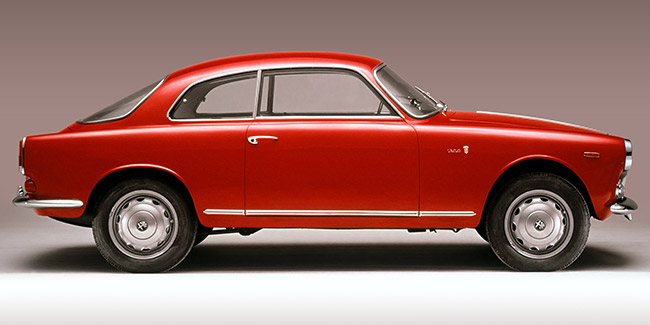

The Alfa Romeo Giulietta sprint was launched in 1954,
it had various configurations but the particular one that this write up will be
looking at is the 2+2 sprint. The Giulietta was available as a Berlina, sprint,
sprint veloce, sprint speciale, a spider and even a station wagon. The Giulietta was first launched in 1954 and
was available only as a 2+2 coupe.
It was designed by Franco Scaglione who was then
working at Bertone. He was born in Florence on 26th September 1916.
He served the Italian army during the second world war, in the year 1951 he
moved to Turin as all the large design firms were present there. His talent
landed him in the famous design firm Bertone. One of his first few designs was
the Fiat 1100. He was a very talented coach builder.

When the Giulietta was first launched it had a very
advanced twin camshaft and was a very high revving motor constructed using
aluminum alloy, the gearbox was manufactured using same material. The capacity
of the engine was 1290 cc, the gear box was a 4-speed manual in the ss and the
sz variant got a five speed.

After World War II, though, Alfa Romeo boldly entered
a market into which it had never before ventured, the market being the family
saloon market. They entered the market with a car that stayed true to the
essence of pre-world war 2 Alfa Romeo, which was sleek, fast looking and curved
line body style, with an engine that produced true music to an enthusiast’s
ears. The Giulietta is the first sports sedan and not BMW’s 2002s. Even the
Giulietta Berlina had some very sporty mechanicals inside, for example the
brakes were finned aluminum drum brakes. The rear axle housed an aluminum
deferential. The suspension duty was taken care of coil overs instead of leaf
springs, since the car weighed next to nothing it would take corners well.

The 1,290cc engine was not particularly powerful but
had a sense of polished sophistication, the entire car truly visualized
complexity in simplicity, the Giulietta can be considered as a true analog car
and an analog car that came at the end of the analog era. One must remember
that this car marked the turning point for Bertone, in order to compensate for
the delay of the Giulietta Alfa commissioned Bertone to create the coupé
version of the new 1300, with 1,000 units to be produced At the Turin Motor
Show in 1954.

Design aspect
When I first saw the Giulietta on the streets of San
Francisco I was just awestruck the car has just one body line on either side
that starts from the hood and runs till the boot, the curved door and fenders,
in fact the entire car is rounded giving it this muscular yet elegant look. The
Sprint especially visualizes Italian design like no other car. People like to
call Alfa’s as the poor man’s Ferrari, well it kind of is but at the same time
it is just as beautiful too look at hear and drive, if not better. The earlier
Giulietta’s were built by Bertone who made the exterior and the interiors were
built by Ghia. Later production was completely taken over by Bertone.
Coming to the spider version of the Giulietta it was
the famous American car importer Max Hoffman who convinced Alfa to build a
spider version, and amongst many other designers it was Pininfarina who ended
up designing and coach building the cars.
Born out of a destroyed Giulietta Sprint
Veloce, the Zagato-bodied “SVZ” displayed how altering material and body
styling can drastically improve speed and agility. Once Zagato and Alfa Romeo
displayed the first Giulietta Sprint Zagato at the 1960 Geneva Motor Show,
this new design and materials used made it a 160 KG lighter than the standard
car and also more aero dynamic. The SVZ hence was a truly good car for racing
from factory.

 |
| Alfa Romeo Giulietta spider |
conclusion
The modern rules and regulations along with the change
in perception make coach-built cars like the Giulietta very niche. It is an era
of cars from Italy that definitely left a mark in the car world.

Comments
Post a Comment